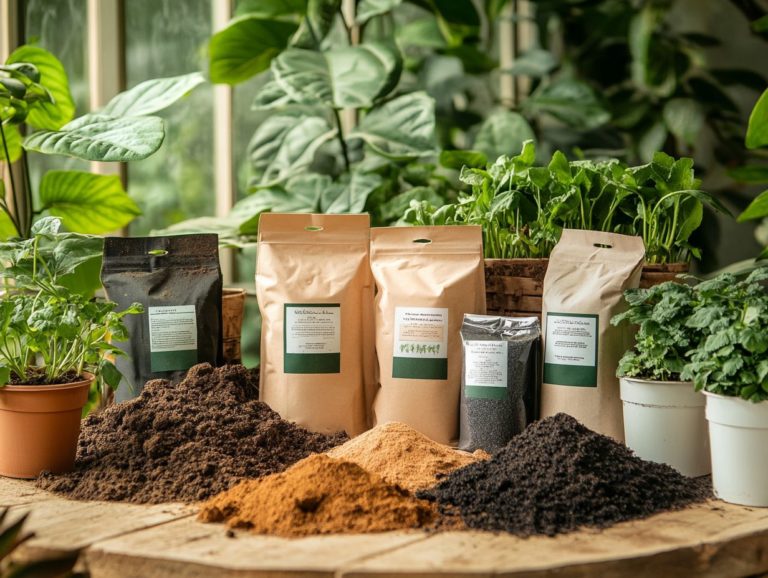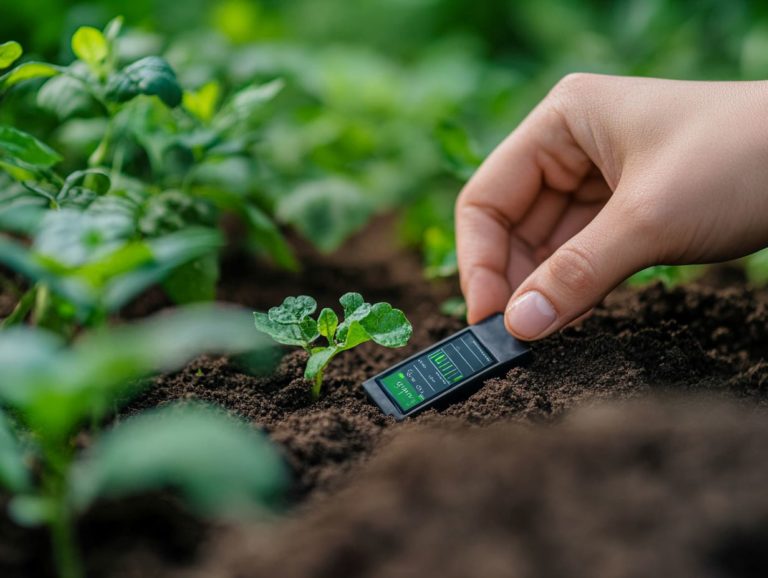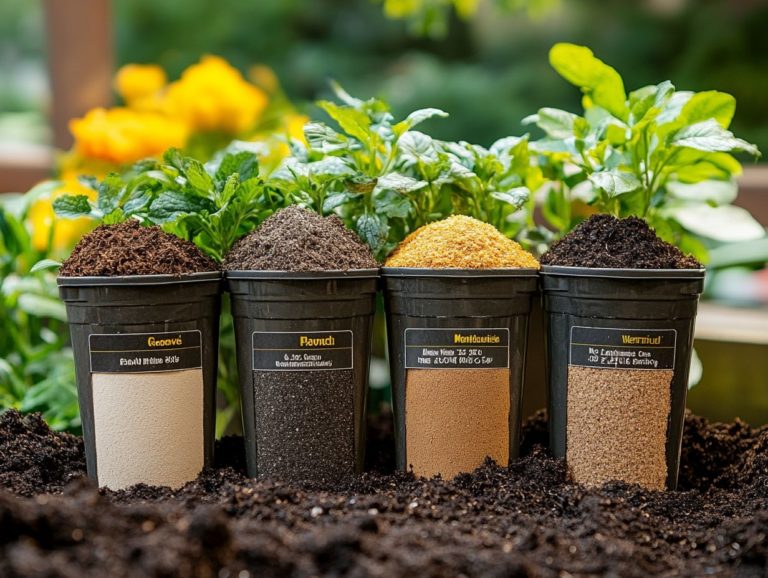Exploring the Benefits of Soil Testing
Soil testing is an essential practice that helps you understand the health and composition of your soil. Analyzing its properties reveals insights that promote optimal plant growth.
This article delves into the significance of soil testing, providing you with a comprehensive overview of its various types, guidance on conducting a test, and tips for interpreting the results. You’ll discover practical methods to enhance your soil’s health and yield, ensuring that your gardening and agricultural endeavors flourish.
Contents
Key Takeaways:
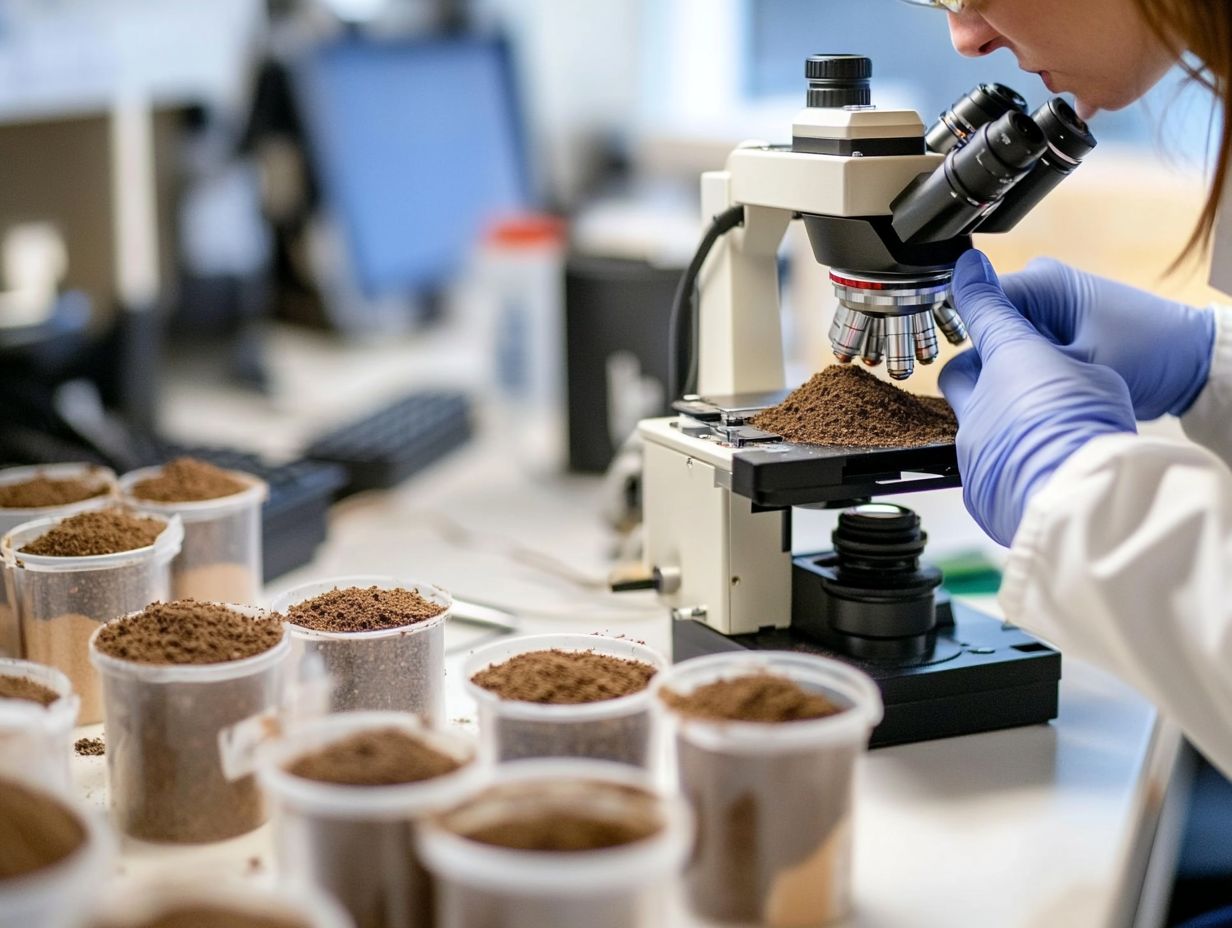
- Soil testing is the process of analyzing soil to determine its composition and nutrient levels, providing crucial information for effective gardening and farming practices, including assessing soil depth and environmental impact.
- Conducting soil tests and interpreting results can lead to increased crop yield, improved plant health, and more efficient use of fertilizers and soil amendments.
- By regularly testing and improving soil health, gardeners and farmers can promote sustainable agriculture practices and contribute to a healthier ecosystem.
What is Soil Testing?
Soil testing is an essential procedure that entails gathering soil samples from different spots in your garden or farmland to assess its chemical properties, nutrient levels, and overall health.
Understanding the soil composition enables you to make well-informed choices about fertilization and organic amendments, which are crucial for enhancing plant growth and maximizing crop yields in your outdoor space.
This process allows you to pinpoint deficiencies, evaluate pH levels (which measure soil acidity or alkalinity), and ascertain the soil’s suitability for various plant species. Ultimately, this leads to improved soil management and conservation practices.
Definition and Purpose
Soil testing is defined as an organized study of soil that allows you to evaluate its nutrient levels, pH, and overall health. This process guides effective soil management.
By identifying deficiencies or excesses in essential elements like nitrogen, phosphorus, and potassium key players in plant growth you gain valuable insights. Understanding the composition and condition of your soil enables you to make informed decisions about fertilizer application and crop rotation strategies.
Engaging in soil testing supports sustainable agricultural practices while enhancing soil fertility and quality, ensuring you achieve higher yields and promote environmental conservation. Regular assessments empower you to allocate resources better and refine soil conservation techniques, fostering a more productive and resilient ecosystem.
Why is Soil Testing Important?
Soil testing is vital for thriving gardens and robust crops! It offers invaluable insights into nutrient levels and the overall health of the soil factors that are vital for both agriculture and gardening, especially in managing soil contaminants and enhancing overall soil health.
By comprehending the conditions of the soil, you empower yourself to make informed decisions regarding fertilization and organic amendments. This not only enhances crop production and promotes healthier plants, but also minimizes environmental impact through improved nutrient management.
Benefits for Agriculture and Gardening
The advantages of soil testing for agriculture and gardening are numerous and impactful, leading to improved nutrient management and enhanced crop production. For those interested in getting started, understanding how to test your soil quality effectively is crucial for achieving healthier plants.
By accurately evaluating nutrient levels and pH balance in your soil, you can make informed decisions that directly affect your crop yields and plant vitality. Think of soil testing as your diagnostic tool it reveals any deficiencies or excesses of essential minerals like nitrogen, phosphorus, and potassium.
Armed with this knowledge, you can customize your fertilization strategies, applying the right amounts of nutrients at optimal times. This approach accelerates plant growth while supporting sustainable practices. Ultimately, regular soil testing cultivates robust soil health, nurturing a thriving ecosystem that benefits your crops and supports long-term agricultural sustainability.
Types of Soil Testing
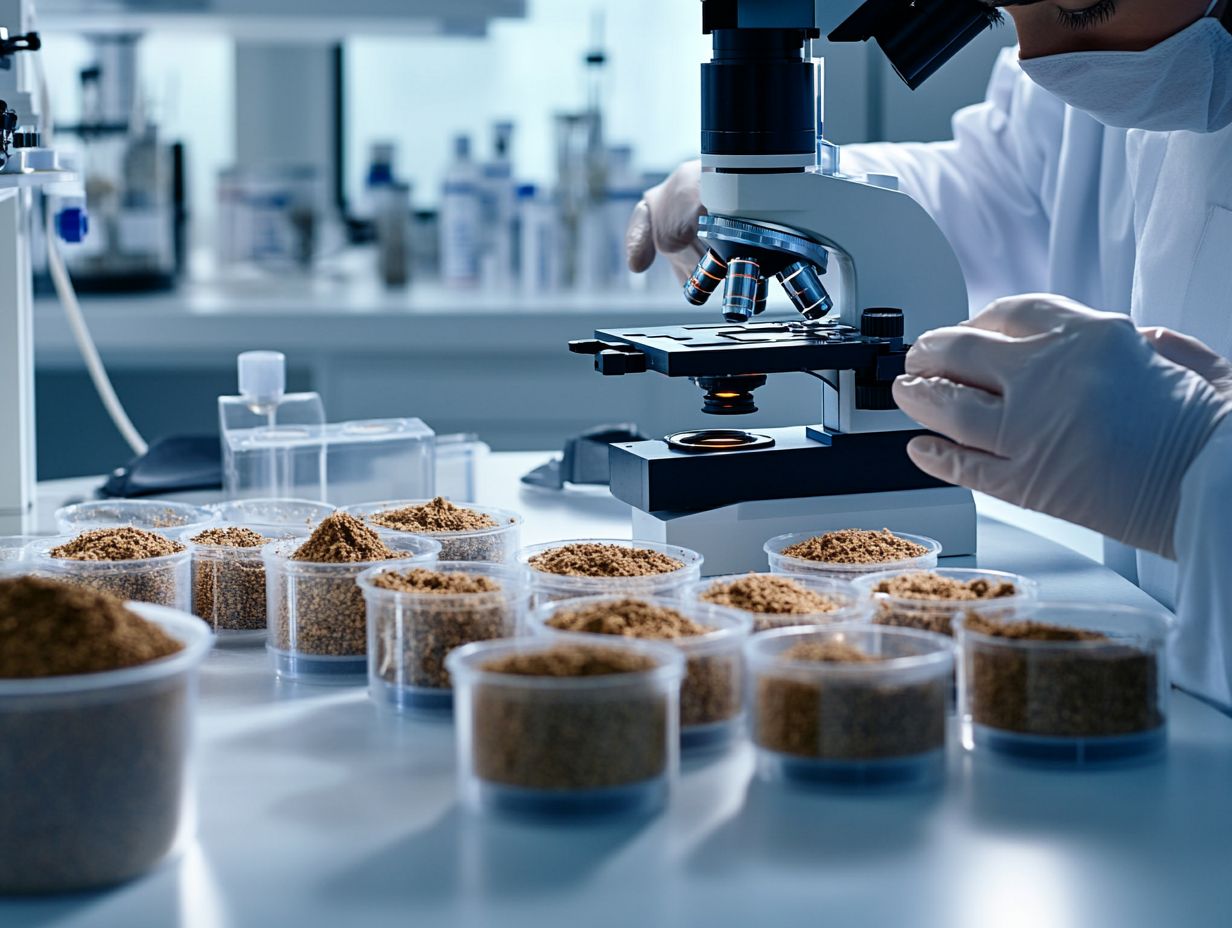
There are several types of soil testing. Each type assesses different aspects of soil analysis, including its physical, chemical, and biological properties, which dictate soil quality and health.
Physical analysis delves into the texture and structure of the soil. Chemical analysis scrutinizes nutrient levels, pH, and any potential contaminants. Biological analysis focuses on the microbial life within the soil, a crucial factor in nutrient cycling and the decomposition of organic matter.
Physical, Chemical, and Biological Analysis
The three primary categories of soil testing physical, chemical, and biological offer you a comprehensive understanding of soil health, texture, and nutrient levels, crucial for optimal land use.
Each type plays a vital role in assessing your soil’s condition. Physical analysis focuses on soil texture, structure, and moisture retention key factors for effective water infiltration and strong root development.
Chemical analysis evaluates nutrient availability, pH levels, and salinity, allowing you to gauge the soil’s fertility and identify potential toxicities. Meanwhile, biological analysis examines the microbial population and organic matter content, indicating ecosystem health and nutrient cycling.
Together, these analyses create an intricate picture of your soil s ability to support plant growth, empowering you, as a farmer or land manager, to make informed decisions for sustainable practices.
How to Conduct a Soil Test
Conducting a soil test requires a careful method that guarantees precise results. Start with the careful collection of soil samples from your garden or agricultural land. Collect samples from different areas to get a complete picture of your soil!
Once you have your samples, you can either use testing kits or send them to certified labs that specialize in soil testing for an in-depth examination of nutrient levels, pH, and contaminants. This information is crucial for understanding your soil’s health and making well-informed decisions about fertilization.
Step-by-Step Guide
A step-by-step guide to conducting a soil test begins with proper soil sampling techniques to achieve representative results. Start by using testing kits or sending samples to soil testing labs for a comprehensive analysis.
Your journey into effective soil testing begins with selecting an appropriate location and timing. Ideally, steer clear of periods right after heavy rainfall. Collect samples from various spots within your area of interest. Be mindful to remove any debris or organic material that might skew your results.
Best practices recommend using a clean, dry tool for sampling like a spade or auger to maintain the purity of your samples. After collecting the samples, mix them thoroughly in a clean container for a more accurate representation of the soil’s overall composition.
Depending on your objectives, whether for agricultural purposes or environmental assessments, secure these combined samples and send them to certified labs that specialize in soil testing for meticulous analysis. A range of factors, including pH levels, nutrient content, and contaminants, will be carefully examined to provide you with valuable insights.
Interpreting Soil Test Results
Interpreting soil test results is essential for understanding nutrient levels, pH, and potential deficiencies. This includes identifying issues related to acidity and alkalinity, informing the soil management practices vital for optimizing plant growth.
By carefully analyzing these results, you can receive customized recommendations for fertilization and soil amendments. This not only ensures an appropriate nutrient balance but also effectively addresses any soil health issues, such as acidity or alkalinity, paving the way for thriving plants.
Want to ensure your crops thrive? Understanding Nutrient Levels and Recommendations
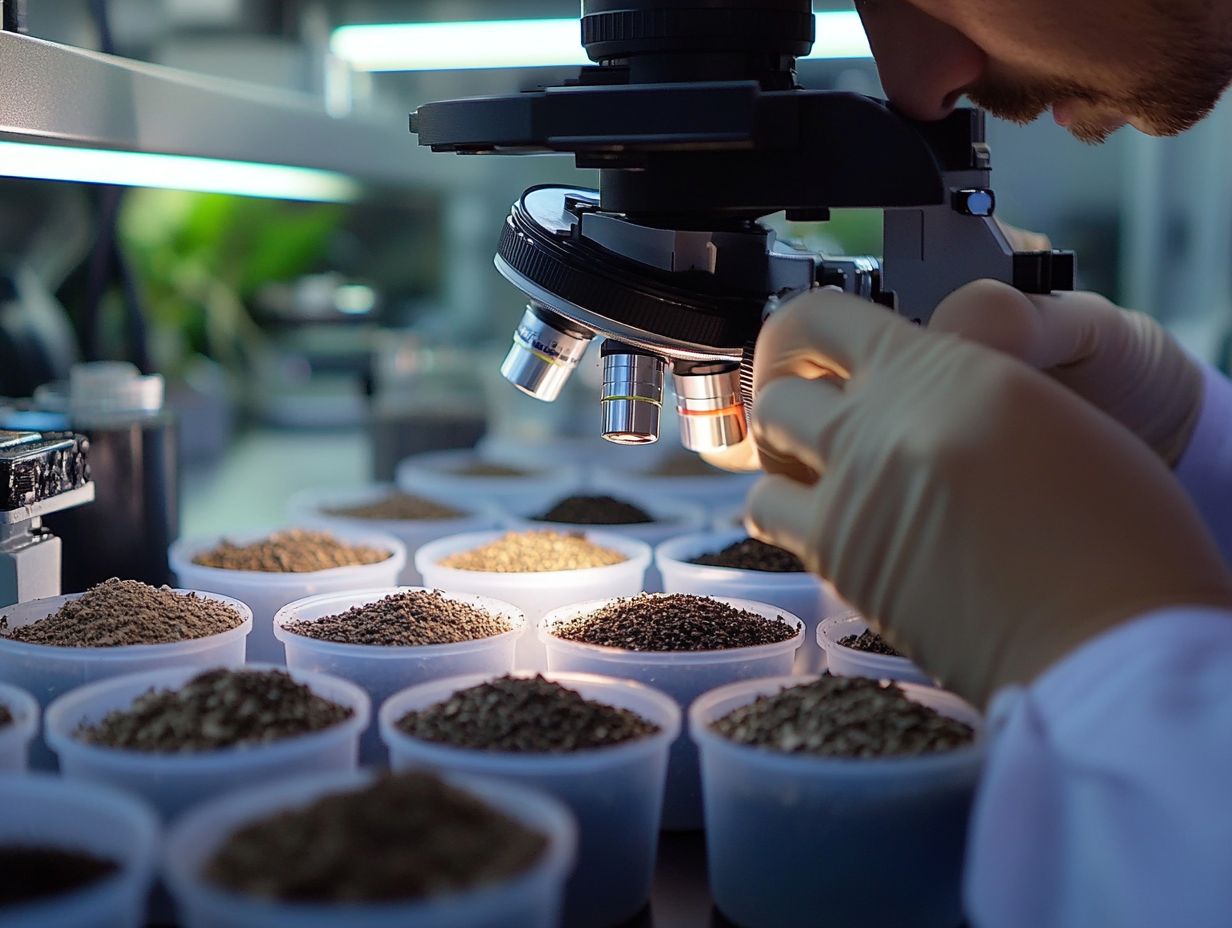
Understanding nutrient levels and recommendations from soil test results is crucial for effective soil management. This knowledge enables you to make targeted amendments that address any deficiencies.
By accurately interpreting these results, you can determine whether essential elements like nitrogen, phosphorus, and potassium are present in optimal quantities or if adjustments are needed to enhance soil health and boost crop yield. For instance, if your tests reveal low nitrogen levels, you might explore adding organic amendments like compost or incorporating cover crops to increase nutrient availability. Similarly, grasping the pH levels can guide your lime application, ensuring that plants can efficiently uptake nutrients.
Ultimately, regular soil testing gives you the power to cultivate balanced ecosystems, promoting sustainable practices in your agricultural land and leading to healthier harvests.
Using Soil Testing to Improve Soil Health and Conservation
Using soil testing to enhance soil health is a strategic approach that allows you to identify deficiencies and optimize nutrient balance through tailored amendments and management practices.
By implementing techniques such as incorporating organic fertilizers and using soil-saving practices, you can significantly improve soil quality, boost water retention, and reduce erosion. This not only cultivates a healthier outdoor space but also paves the way for superior crop production.
Methods for Soil Improvement
Methods for improving soil quality often involve applying organic fertilizers, materials added to soil to improve its quality, and conservation practices that enhance both soil structure and nutrient availability.
To achieve sustainable results, consider incorporating compost into your routine. It enriches the soil with essential nutrients such as nitrogen, phosphorus, and potassium while also improving its texture.
Cover crops act as a protective shield, preventing erosion and suppressing weeds, which further contributes to overall soil health. Implementing growing different crops in a sequence is another highly effective strategy; it disrupts pest cycles and promotes nutrient diversity.
Additionally, mulching helps retain moisture and stabilize temperatures. These integrated techniques, guided by soil test results, foster a thriving ecosystem. They encourage the presence of beneficial microorganisms and significantly enhance overall soil resilience.
Frequently Asked Questions
What is soil testing and why is it important?
Soil testing is the process of analyzing a sample of soil to determine its chemical composition, nutrient levels, and other properties. It is important because it helps farmers and gardeners make informed decisions about fertilization and soil amendments, leading to healthier plants and increased yields.
How does soil testing benefit farmers and gardeners?
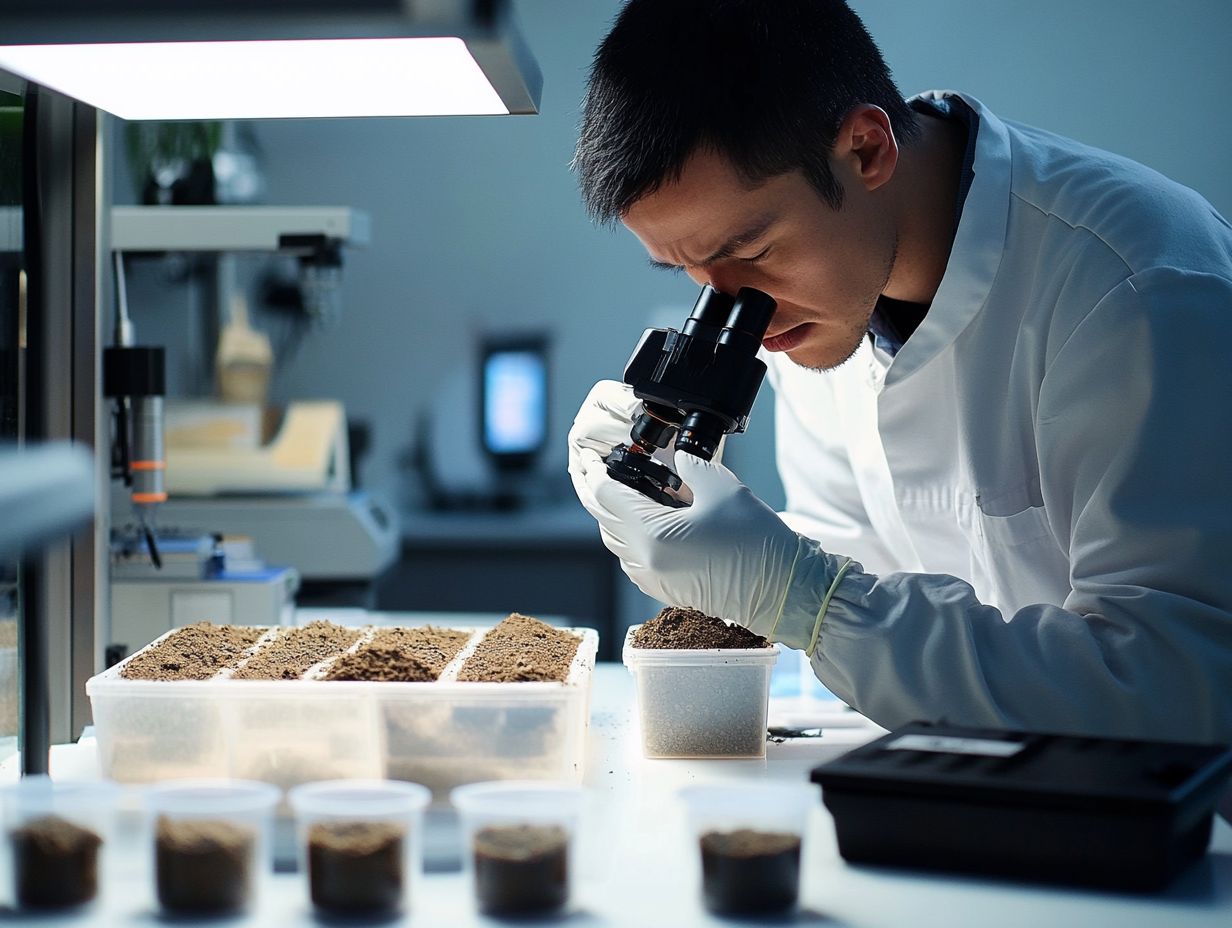
Soil testing provides crucial information about health and fertility of the soil, allowing farmers and gardeners to determine the best course of action for their specific crops or plants. This can result in cost savings on unnecessary fertilizers and amendments, as well as improved plant growth and quality.
What are the potential consequences of not testing soil?
Not testing soil can lead to several negative consequences. Without knowing the nutrient levels and pH of the soil, farmers and gardeners may over- or under-fertilize, resulting in decreased yields or plant health. Soil deficiencies can go unnoticed and cause long-term damage to the soil and crops.
How often should soil testing be done?
The frequency of soil testing depends on several factors, such as the type of crops or plants being grown, the history of the soil, and the type of testing being done. In general, it is recommended to test soil at least once every two to three years, or whenever there are changes in soil management practices.
Can soil testing help with environmental and sustainability goals?
Absolutely! Soil testing is vital for meeting environmental and sustainability objectives.
By understanding soil nutrients and properties, farmers and gardeners can apply fertilizers more effectively. This approach reduces the risk of excess nutrients washing away and contaminating our water sources.
Is soil testing expensive and complicated?
No, it’s neither expensive nor complicated. You can find many easy-to-use and wallet-friendly soil testing kits.
Many local agricultural extension offices also provide affordable soil testing services. Numerous online resources are available to help you understand your soil test results and manage your soil effectively.


